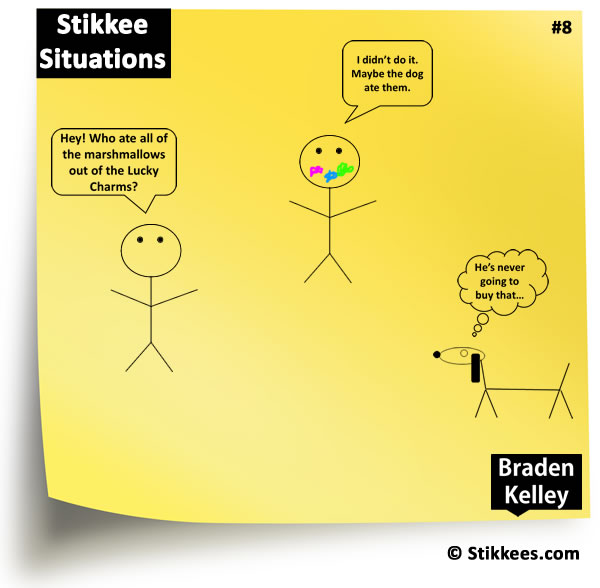
It seems like every company these days is trying to claim that they are innovative, trying to claim that they are customer-centric, trying to claim that their employees are important to them. But are they?
Can all this be true?
Or, are all of these companies lying to their customers, lying to their employees, and lying to their shareholders?
Many companies say that they are committed to innovation, but employees know the truth. If employees’ experience around the innovation efforts of the company (and its outcomes) isn’t consistent with the innovation messages being communicated, then not only will innovation participation and outcomes be low, but ongoing trust and loyalty will be further eroded in the organization.
Employees can see the Lucky Charms on your face when you say you’re committed to innovation publicly, but behind the scenes your actions demonstrate that you really are not.
And don’t be fooled, customers will start to see the Lucky Charms show up on your face, no matter how hard you try and convince them that the marshmallow goodness is not there.
If you aren’t going to define what innovation means to your company, if you aren’t going to create a common language of innovation, if you aren’t going to teach people new innovation skills and support innovation at all levels by making limited amounts of time and capital available to push their ideas forward, then don’t say you’re committed to innovation. You’ll tear the organization down instead of building it up.
 If customers don’t see you increasing your level of value creation, improving your level of value access, and doing a better job at value translation (see Innovation is All About Value), especially when compared to the competition, then they too will become disillusioned, frustrated, and start to look for other alternative solutions that deliver more value then all of your offerings.
If customers don’t see you increasing your level of value creation, improving your level of value access, and doing a better job at value translation (see Innovation is All About Value), especially when compared to the competition, then they too will become disillusioned, frustrated, and start to look for other alternative solutions that deliver more value then all of your offerings.
Meanwhile, shareholders behave like customers on steroids. If you are being rewarded with an innovation premium by the market, you can’t be “all hat and no cattle” for very long, meaning you have to deliver compelling inventions on a repeated basis with a strong potential to become the innovations that drive the future growth of the company. This is hard to do once, let alone on a repeated basis. We will likely see Apple be the latest victim in the next twelve months.
Why? Because AAPL is at an all-time high based on the likely high percentage of people that are likely to upgrade from an iPhone 4 or 5s to an iPhone 6 or 6 Plus. What about after that? Well, the smartphone industry is about to enter the same place that the PC industry hit a few years ago, when replacement cycles began to lengthen, reducing revenues, and forcing prices (and margins) lower. Simultaneously carriers will seek to extract more of the margin from the overall equation, and if Google/Motorola/Lenovo, Nokia and others start to bring $99 smartphones developed for India and other places to the richer economies that will in their next generation likely be “good enough” compared to the high end $699 handsets, more people will choose to wait longer between upgrades, or trade down with their next purchase, much as they did when $400 laptops started to become the rage.
So, what are we to learn from Apple’s pending share price collapse about the middle of next year?
Well, the first thing we will learn is that continuous innovation is hard. Now I’m not saying that Apple is going to go away, HP and Dell haven’t gone away, but Apple’s share price in Q2/Q3 2015 will struggle, they will face employee defections, and it will become more like Dell, HP and Microsoft than Facebook or Google. Not because those companies are any more or less innovative than any of the others, but because the growth paradigms are different and those companies are still in a different place on their growth curves.
We can also learn that continuous innovation requires consistency, commitment, the ability to recognize and prepare for the inevitable peaking of any growth curve, the organizational agility necessary to change as fast as the wants and needs of your customers and your environment, and the ability to understand what your customers will give you permission to do (so you know where to go next when your most profitable growth curve begins to peak).
You should see by now that continuous innovation is about far more than technological innovation, but instead requires not only continuous commitment, but also a continuous willingness and ability to change, and a continuous scanning of your environment using a Global Sensing Network.
Do you have one?
What is yours telling you about your company’s future?
Please note the following licensing terms for Stikkee Situations cartoons:
| 1. BLOGS – Link back to http://stikkeechange.com/category/stikkees/ and you can embed them for free | |
| 2. PRESENTATIONS, please send $25 to me on PayPal by clicking the button | 3. NEWSLETTERS & WEB SITES, please send me $50 on PayPal by clicking the button |
![]() Sign up here to get Human-Centered Change & Innovation Weekly delivered to your inbox every week.
Sign up here to get Human-Centered Change & Innovation Weekly delivered to your inbox every week.